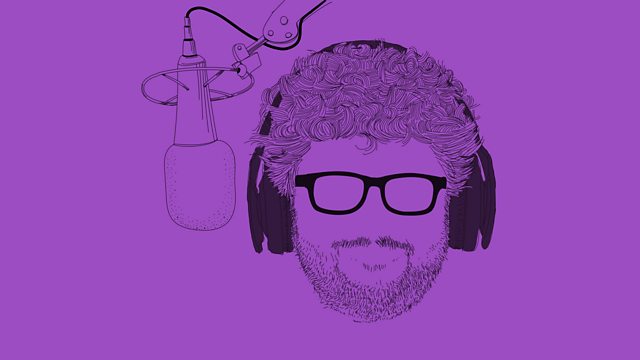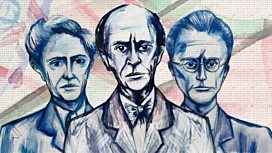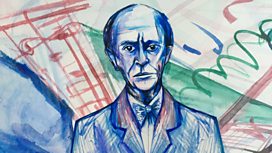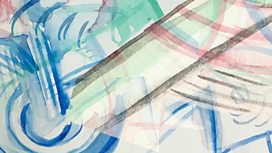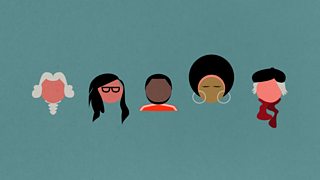Breaking Free: Tom Service on the Second Viennese School
As part of Radio 3's Breaking Free season, Tom Service considers how to listen to the Second Viennese School, which developed from early expressionist ventures into atonality.
Breaking Free - the minds that changed music. Tom Service explores how to listen to the Second Viennese School - music that exploded with expressive feeling in the early years of the 20th century, and then gradually rebuilt harmony into a new system, using the 12-note series. He explains how the music developed from Arnold Schoenberg's early expressionist ventures into atonality, to the cool jewel-like precision of his pupil Anton Webern. In conversation with art historian Lisa Florman, he finds parallels in the painter Wassily Kandinsky's journey towards abstraction and his theories of shapes and colours. (Kandinsky was a friend of Schoenberg). And composer George Benjamin describes the intricate structures of Webern's music, which greatly inspired his own compositions.
Last on
More episodes
Previous
![]()
The objects that personify the Second Viennese School.
![]()
Explore Radio 3's Breaking Free season.
![]()
Understanding the Second Viennese School in 20th-century music.
Clip
-
![]()
How did the number 12 revolutionise music?
Duration: 03:00
Music Played
-
![]()
Alban Berg
Wozzeck - Act 1 Sc.3
Performer: Vienna Philharmonic. Performer: Claudio Abbado.- Wozzeck.
- DG.
-
![]()
Franz Liszt
Faust (Faust Symphony)
Orchestra: Budapest Festival Orchestra. Conductor: Iván Fischer.- PHILIPS.
-
![]()
Wolfgang Amadeus Mozart
Symphony no. 40 (K.550) in G minor, 4th movement; Allegro assai
Conductor: Charles Mackerras. Orchestra: Scottish Chamber Orchestra.- Mozart; Symphonies 38-41; SCO; Sir Charles Mackerras.
- Linn.
-
![]()
Anton Bruckner
Symphony no.9, Adagio
Performer: Royal Concertgebouw Orchestra. Performer: Bernard Haitink.- Philips.
-
![]()
Arnold Schoenberg
Six Little Piano Pieces Op.19 no.1
Performer: Mitsuko Uchida.- Philips.
-
![]()
Arnold Schoenberg
Six Little Piano Pieces Op.19 no.4
Performer: Mitsuko Uchida.- Philips.
-
![]()
Alban Berg
3 Orchestral Pieces Op.6
Performer: Berliner Philharmoniker. Performer: James Levine.- Philips.
-
![]()
Arnold Schoenberg
Erwartung
Performer: Metropolitan Opera Orchestra. Performer: James Levine.- Philips.
-
![]()
Arnold Schoenberg
String Quartet no.2, 4th mvt
Performer: Quatuor Diotima.- NAIVE.
-
![]()
Arnold Schoenberg
5 Pieces for Piano, Op 23, 5. Waltz
Performer: Glenn Gould.- Works by Schoenberg.
- CBS.
- 8.
-
![]()
Arnold Schoenberg
Variations for Orchestra Op. 31
Performer: Berliner Philharmoniker. Performer: Herbert von Karajan.- DG.
-
![]()
Arnold Schoenberg
String Quartet No. 4, Op. 37
Performer: Schoenberg Quartet.- String Quartets.
- Chandos.
-
![]()
Arnold Schoenberg
Concerto for Piano, Op. 42
Performer: Mitsuko Uchida. Performer: The Cleveland Orchestra. Performer: Pierre Boulez.- Philips.
-
![]()
Arnold Schoenberg
Moses Und Aron
Performer: Chicago Symphony Chorus and Orchestra. Performer: Georg Solti.- Moses Und Aron.
- Decca.
-
![]()
Anton Webern
Symphony Op.21, 1st Movement
Performer: Berliner Philharmoniker. Performer: Pierre Boulez.- Philips.
-
![]()
Anton Webern
5 Pieces Op.10 no.4
Performer: Ensemble intercontemporain. Performer: Pierre Boulez.- Philips.
Broadcast
- New Year's Day 2017 17:00�鶹������ҳ��� Radio 3
Why do we call it 'classical' music?
Tom Service poses a very simple question (with a not-so-simple answer).
Six of the world's most extreme voices
From babies to Mongolian throat singers: whose voice is the most extreme of all?
How did the number 12 revolutionise music?
Why are we all addicted to bass?
Watch the animations
Join Tom Service on a musical journey through beginnings, repetition and bass lines.
When does noise become music?
We like to think we can separate “noise” from “music”, but is it that simple?
Podcast
-
![]()
The Listening Service
An odyssey through the musical universe, presented by Tom Service
